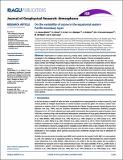Por favor, use este identificador para citar o enlazar a este item:
http://hdl.handle.net/10261/142041COMPARTIR / EXPORTAR:
 SHARE SHARE
 CORE
BASE CORE
BASE
|
|
| Visualizar otros formatos: MARC | Dublin Core | RDF | ORE | MODS | METS | DIDL | DATACITE | |

| Título: | On the variability of ozone in the equatorial eastern Pacific boundary layer |
Autor: | Gómez Martín, J. C.; Vömel, H.; Hay, T.D.; Mahajan, Anoop S.; Ordóñez, C. CSIC ORCID; Parrondo Sempere, M.C.; Gil-Ojeda, M.; Saiz-Lopez, A. CSIC ORCID | Fecha de publicación: | 2016 | Editor: | American Geophysical Union | Citación: | Journal of Geophysical Research: Atmospheres 121: 11,086- 11,103 (2016) | Resumen: | Observations of surface ozone (O) mixing ratios carried out during two ground-based field campaigns in the Galápagos Islands are reported. The first campaign, Primera Investigación sobre la Química, Evolución y Reparto de Ozono, was carried out from September 2000 to July 2002. The second study, Climate and HAlogen Reactivity tropicaL EXperiment, was conducted from September 2010 to March 2012. These measurements complement the Southern Hemisphere ADditional OZonesonde observations made with weekly to monthly frequency at Galápagos. In this work, the daily, intraseasonal, seasonal and interannual variability of O in the marine boundary layer are described and compared to those observed in other tropical locations. The O diurnal cycle shows two regimes: (i) photochemical destruction followed by nighttime recovery in the cold season (July to November) and (ii) daytime advection and photochemical loss followed by nighttime depositional loss associated to windless conditions in the warm season (February to April). Wavelet spectral analysis of the intraseasonal variability of O reveals components with periods characteristic of tropical instability waves. The O seasonal variation in Galápagos is typical of the Southern Hemisphere, with a maximum in August and a minimum in February–March. Comparison with other measurements in remote tropical ocean locations shows that the change of the surface O seasonal cycle across the equator is explained by the position of the Intertropical Convergence Zone and the O levels upwind. | URI: | http://hdl.handle.net/10261/142041 | DOI: | 10.1002/2016JD025392 | Identificadores: | doi: 10.1002/2016JD025392 issn: 2169-8996 |
| Aparece en las colecciones: | (IQF) Artículos |
Ficheros en este ítem:
| Fichero | Descripción | Tamaño | Formato | |
|---|---|---|---|---|
| jgrd53306.pdf | 2,76 MB | Adobe PDF |  Visualizar/Abrir |
CORE Recommender
SCOPUSTM
Citations
2
checked on 17-abr-2024
WEB OF SCIENCETM
Citations
2
checked on 23-feb-2024
Page view(s)
256
checked on 18-abr-2024
Download(s)
368
checked on 18-abr-2024
Google ScholarTM
Check
Altmetric
Altmetric
NOTA: Los ítems de Digital.CSIC están protegidos por copyright, con todos los derechos reservados, a menos que se indique lo contrario.
